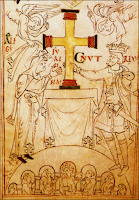Learning Disabilities and the Foundling Hospital

Fascinating online talk from the Foundling Museum looking at how children with what we would now call learning disabilities were treated by the Founding Hospital. Thomas Aird, a volunteer at the Museum, took us through some detailed research he had done on children listed as ‘idiots’ at various times in the hospital, tracking what had happened to them over the years. I was fascinated by the amount of detail he had found on the children, often finding where they had been placed in apprenticeships and in some cases finding out when they died and where they are buried. Most touching was Ann Valley who lived in the care of the Foundling Hospital for the whole of her 83 years. He explained that the term ‘idiot’ was not seen as derogatory at the time, it only became so as narrower definitions of conditions were adopted. He also explained how the issue had become more pronounced following the period of general admission to the hospital between 1756 and 1760 when, in return for government














